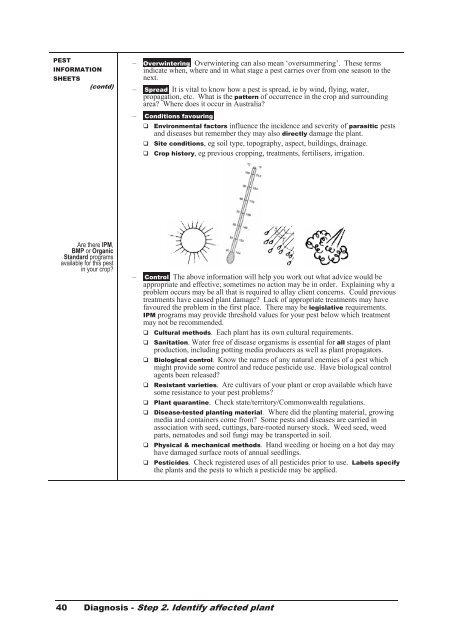PLANT PROTECTION 4
PLANT PROTECTION 4
PLANT PROTECTION 4
You also want an ePaper? Increase the reach of your titles
YUMPU automatically turns print PDFs into web optimized ePapers that Google loves.
PEST<br />
INFORMATION<br />
SHEETS<br />
(contd)<br />
Are there IPM,<br />
BMP or Organic<br />
Standard programs<br />
available for this pest<br />
in your crop?<br />
– Overwintering. Overwintering can also mean ‘oversummering’. These terms<br />
indicate when, where and in what stage a pest carries over from one season to the<br />
next.<br />
– Spread. It is vital to know how a pest is spread, ie by wind, flying, water,<br />
propagation, etc. What is the pattern of occurrence in the crop and surrounding<br />
area? Where does it occur in Australia?<br />
– Conditions favouring.<br />
Environmental factors influence the incidence and severity of parasitic pests<br />
and diseases but remember they may also directly damage the plant.<br />
Site conditions, eg soil type, topography, aspect, buildings, drainage.<br />
Crop history, eg previous cropping, treatments, fertilisers, irrigation.<br />
– Control. The above information will help you work out what advice would be<br />
appropriate and effective; sometimes no action may be in order. Explaining why a<br />
problem occurs may be all that is required to allay client concerns. Could previous<br />
treatments have caused plant damage? Lack of appropriate treatments may have<br />
favoured the problem in the first place. There may be legislative requirements.<br />
IPM programs may provide threshold values for your pest below which treatment<br />
may not be recommended.<br />
Cultural methods. Each plant has its own cultural requirements.<br />
Sanitation. Water free of disease organisms is essential for all stages of plant<br />
production, including potting media producers as well as plant propagators.<br />
Biological control. Know the names of any natural enemies of a pest which<br />
might provide some control and reduce pesticide use. Have biological control<br />
agents been released?<br />
Resistant varieties. Are cultivars of your plant or crop available which have<br />
some resistance to your pest problems?<br />
Plant quarantine. Check state/territory/Commonwealth regulations.<br />
Disease-tested planting material. Where did the planting material, growing<br />
media and containers come from? Some pests and diseases are carried in<br />
association with seed, cuttings, bare-rooted nursery stock. Weed seed, weed<br />
parts, nematodes and soil fungi may be transported in soil.<br />
Physical & mechanical methods. Hand weeding or hoeing on a hot day may<br />
have damaged surface roots of annual seedlings.<br />
Pesticides. Check registered uses of all pesticides prior to use. Labels specify<br />
the plants and the pests to which a pesticide may be applied.<br />
40 Diagnosis - Step 2. Identify affected plant







![[Compatibility Mode].pdf](https://img.yumpu.com/27318716/1/190x135/compatibility-modepdf.jpg?quality=85)









